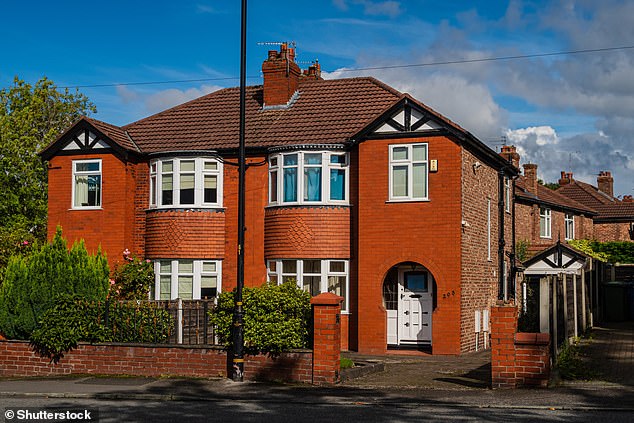We’ve recently moved from a rural area to a large city for my new job.
The house we’ve bought is semi-detached and on a fairly busy road. There are also lots of neighbours nearby which we’re not used to.
What’s the best way to soundproof our house from noisy neighbours and road noise?
How much could this all cost and is any planning permission needed?

Stop the noise: A This is Money reader wants to soundproof their semi-detached house
Jane Denton, of This is Money, replies: It is no surprise that you are wincing at the increase in noise having moved from a rural idyll to the inner city.
Sound can travel in two ways. The first is through the air, such as people talking across a room, while the second is via impact vibrations, like footsteps on floorboards.
Many houses in Britain have thin walls, floors and ceilings without adequate soundproofing or insulation.
If you are willing to put the money into it, there are a myriad of soundproofing options available. You can soundproof walls, ceilings, doors and even floors.
I asked two experts for their advice.
Clive Holland, a broadcaster on Fix Radio, says: Moving from a rural area to a busy city street can definitely make noise a bigger issue, especially in a semi-detached house where neighbours are close by.
The best way to soundproof your home is to take a comprehensive approach – addressing windows, walls, floors and doors. This will help create a much quieter and more comfortable living environment.

Clive Holland is a broadcaster on Fix Radio
I’d start with the windows and doors, as these are often the main entry points for noise.
Upgrading to double or triple glazing can make a huge difference in cutting down outside noise.
For a typical semi-detached house, replacing all the windows might cost between £4,000 and £7,000 depending on the size and type of glazing you choose.
Sealing any gaps around window frames and doors with draught-proofing strips or acoustic seals is also important.
Next, I’d look at the walls. Many older properties lack proper sound insulation, so adding acoustic panels or building a new internal stud wall with insulation can help a lot – as well as keep in warmth.
It usually costs between £50 and £100 per square metre, depending on the materials and whether you hire a professional.
Bear in mind that internal wall insulation will reduce your room size a little, so you’ll want to plan carefully.
Floors are another big factor. If you have suspended timber floors, adding insulation underneath and using carpets with a thick underlay can absorb noise effectively.
For concrete floors, acoustic underlays or floating floors designed to reduce sound work well.
Costs vary but expect to spend at least £1,000 depending on the size of the area and method chosen.
Ceilings shouldn’t be forgotten either, especially for those who get noise from upstairs neighbours.
Adding soundproofing layers beneath the ceiling using resilient bars and acoustic plasterboard is effective, though it can be more disruptive and costly.
Additionally, internal soundproofing generally doesn’t require planning permission since you’re not changing the exterior.
However, if you’re thinking of external changes like secondary glazing or cladding, it’s wise to check with the local council first.
All told, a full soundproofing job from top to bottom could cost between £8,000 and £20,000 depending on the size of your home and the work involved.
It’s a big investment but well worth it for peace and quiet. I’d recommend getting a professional survey and quotes to find the best solution for your property.
Phil Lyons, managing director of The Soundproofing Store, says: Most domestic noise travels through common routes.
In terraced or semi-detached houses, noise often comes through shared party walls, carrying the sounds of voices, TV or music from next door.
In flats, ceilings and floors can transmit footsteps and other impact noise between levels.
Even within your own home, internal stud walls and timber floors can let noise pass from room to room.
And of course, windows and doors are often the weak points when it comes to traffic and street noise outside.
You will need to break the link between the walls and the soundproofing layers to stop sound vibrations travelling through.

Phil Lyons is managing director of The Soundproofing Store
Use specialist soundproofing fixings as they isolate soundproofing layers from the offending wall.
Soak up sound vibrations using elastic, damping materials or closed cell foam.
You can also increase the density of the wall with heavy materials like mass loaded vinyl, FlexiSound and acoustic plasterboard to block airborne noise.
The great thing about soundproofing your wall is that soundproofing works both ways. If you can hear your neighbours, most often than not they can also hear you. Soundproofing one side of the party wall achieves quiet and privacy for both homes.
When it comes to road and street noise, windows and doors are often the most vulnerable areas.
Upgrade to well-fitted, high-spec double or triple glazing with acoustic glass, or adding secondary glazing if replacing the windows isn’t an option.
It’s also crucial to make sure window and door frames are properly sealed to prevent sound leaking through gaps.
Costs for soundproofing vary depending on the size of the area involved.
Soundproofing is an investment in your health and well-being. Done properly, you’ll only need to do it once, and the improvement in your quality of life is priceless.
An expert will be able to provide you with a tailored quote.
You don’t need planning permission to soundproof internal walls, floors, or ceilings as it’s considered internal home improvement.
If you plan to change windows on a listed building, check with your local council first, as you may need consent.











